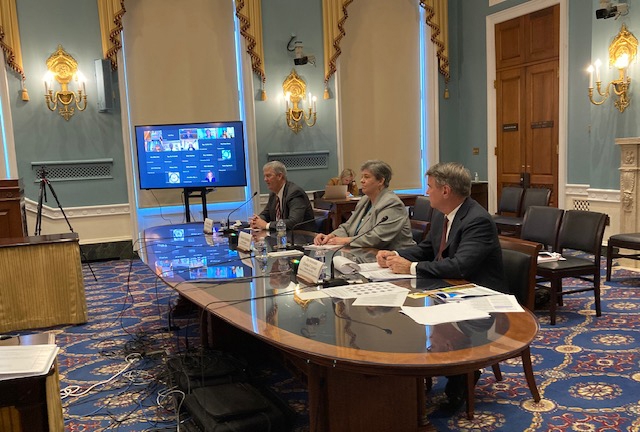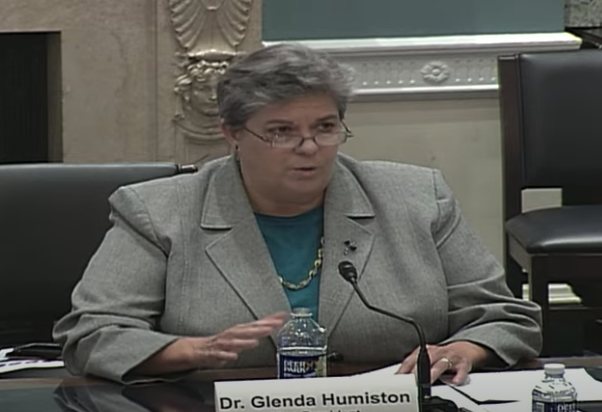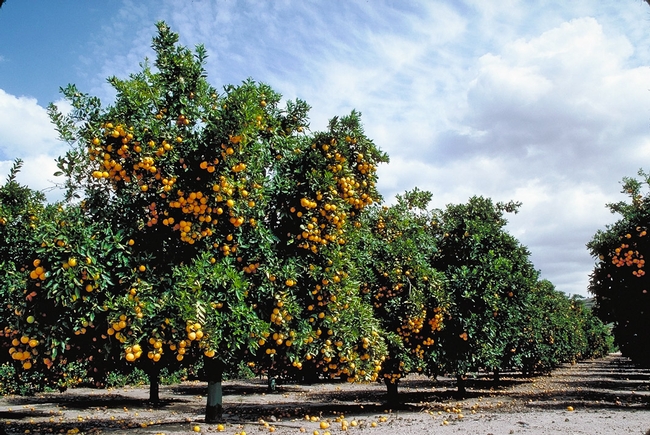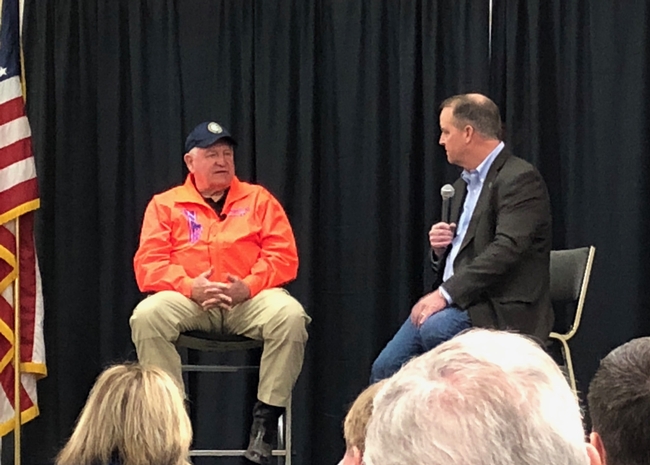Posts Tagged: Farm Bill
Humiston touts USDA climate-smart programs before House agriculture committee
Testimony highlights UC ANR's role in advancing prosperity, sustainability and climate resilience
Glenda Humiston, Ph.D., University of California vice president of agriculture and natural resources, director of the Agricultural Experiment Station and director of the Cooperative Extension Service, testified before the U.S. House of Representatives Committee on Agriculture at today's (March 16) hearing “A 2022 Review of the Farm Bill: The Role of USDA Programs in Addressing Climate Change.”
A recording of the hearing can be viewed at https://youtu.be/2_GQI6b6CCs. Congressman Jimmy Panetta, who represents California's Central Coast, introduces Humiston at the 16-minute mark of the recording. She begins speaking at the 40:38 mark.
In Washington, D.C., Humiston delivered the following prepared statement:
Good morning, Chairman [David] Scott, Ranking Member [GT] Thompson, and Members of the Committee, my name is Glenda Humiston, and I serve as the Vice President of Agriculture and Natural Resources (ANR) for the University of California (UC) system. I am honored to have this opportunity to discuss the importance of agricultural research, and other USDA programs, as you begin work on the next Farm Bill.
With UC ANR serving as a vital partner, California continues to be the nation's top agricultural state. For more than a century, California's $50 billion agricultural sector has depended on UC ANR, in partnership with our UC campuses, for the stream of new technologies and research breakthroughs needed to stay competitive and be responsible stewards of the land. We are proud to be part of the Land Grant partnership that was developed between states and the federal government with the 1862 Morrill Act, 1887 Hatch Act and the 1914 Smith-Lever Act. That enterprise has, for over 130 years, advanced scientific knowledge in all aspects of food production, and improved production capacity, profitability, and safety of the nation's food system.
With over 71,000 farms producing 400 different commodities, California is an agricultural behemoth and the sole provider of many high-demand farm products while also exporting roughly a third of its agricultural production each year. Beyond on-farm production, California's working landscapes include farmland, ranches, forests, wetlands, mines, water bodies and other natural resource lands, both private and public, that are vital sources of ecosystem services. These services are ways that the natural world provides biological necessities, such as clean water, nutritious food, and a livable climate, as well as indirect economic benefits, such as jobs and revenue created along food value chains. More broadly, they encompass intangible goods that contribute to human well-being, such as recreation, aesthetic inspiration, and cultural connection.

To combat such future perils, we must harness the ability of our agricultural and other working landscapes to adapt, to mitigate and where possible, to become a solution to climate change. According to the National Academy of Sciences, U.S. soils and forests have the potential to sequester about 500 million metric tons of carbon dioxide annually. Emerging markets for carbon credits and government incentive programs could generate tens of billions of dollars per year in new investment for working farm and forest lands within the next several years.
Within this framework, USDA programs are critical to our efforts to support carbon sequestration, improved water management, healthy soils, forest restoration, hazardous fuels management, and wood products innovation, among other provisions that support natural climate solutions. USDA's new Partnerships for Climate-Smart Commodities is a great example of how targeted funding for pilot projects can create market opportunities for commodities produced using climate-smart practices.
As we pursue those climate-smart practices, it is critical that we make full use of existing programs and leverage collaborations among them wherever possible. Supporting partnerships between government agencies with academia and the private sector will enable production of multiple benefits from various actions. As part of this we need to utilize voluntary, market and incentive-based programs to the greatest extent possible and maintain a focus on science-based outcomes. In many situations, transformative innovation is needed – moving beyond just improving existing methods and processes to totally re-thinking how our systems are designed to deliver policy and programs.
UC ANR supports California farmers and ranchers to be resilient to extreme weather events with data-driven tools, methods, and technologies. For example, we are developing drought, heat, and pest-tolerant crop varieties that allow farmers to remain economically viable while also being resilient to extreme weather. Finding new crops suitable for California soils and ecosystems not only improves the productivity of the farm but can have co-benefits such as improving water-holding capacity of the soil, increasing native pollinator habitat, and boosting local economies by increasing value-added products.
We are also pushing our research system to expand collaborative efforts between experts in soil sciences, plant pathology, biochemistry, and other sciences with technology experts in robotics, sensors, artificial intelligence, materials, supply chain logistics, and energy systems to solve today's complex problems in agriculture. Much like the biomedical revolution, it is the integration of multiple disciplines into a single project that can lead to transformative innovation that improves productivity, food safety, and ecosystem services while also giving rise to new businesses. Great examples of such transdisciplinary research and development include:
- An initiative to place solar panels over irrigation canals to reduce evaporation of precious irrigation water supplies for farmers while also producing electricity.
- Implementing healthy soil practices, like cover crops and no-till, to enhance capture of rain and improve groundwater recharge.
- Programs for farmers to install dairy digesters to convert potentially harmful greenhouse gases into valuable biofuels.
To develop the science, new technologies and better farming practices that are desperately needed, increased funding for agriculture and food-related research and extension is necessary as are new investment in agricultural research facilities. Public funding for agricultural research in the U.S. has declined in real dollars over the past few decades while deferred maintenance of research facilities greatly hampers scientists' work. Greater investments will help ensure farmers and ranchers have access to the scientifically rigorous tools and information they need to build climate resilience, mitigate environmental impacts, and increase the productivity of their land.
Other exciting opportunities can be found in forest health efforts that convert excessive fuel loads – biomass – into valuable bioproducts while reducing risk from catastrophic wildfires. California's wildfire crisis continued its destructive march in 2020, each year worse than the one before. Working closely with regional economic development organizations and our California Economic Summit partners, UC ANR is a key partner in developing and implementing recommendations to improve forest health, reduce wildfire risk, incentivize innovation in new and innovative wood products industries and build capacity for manufacturing to enhance forest and environmental health and resilient rural communities. Examples of this work include:
- Organizing controlled burn associations with local communities and other forest treatment practices such as a software program, Match.Graze, that improves use of grazing.
- Partnering with the Inland Empire Economic Partnership and the southern California commercial ports to convert biomass into hydrogen and other liquid biofuels to replace diesel in trucks – the largest source of air pollution in that region.
- Educating homeowners on landscaping, defensible space, and fire-wise plants to improve home-hardening, reduce risk from fire and conserve water.
- UC Engineering research on materials science is developing new advanced wood products and data to demonstrate the multiple values of construction with such products.
- Teaming up with community colleges to provide workforce training in forest professions.
The US needs robust funding for wildfire prevention, research, recovery, and extension. Cooperative Extension academics are lead experts in forestry and wildfire research and they provide critical resources to inform strategic fuels management, enhance community wildfire planning, and build community fire adaptation and resiliency. USDA's Climate Hubs should be expanded so that they can regularly engage stakeholders and prioritize vital research amongst more partners. The U.S. Forest Service's work on bioproducts is extremely valuable as is their willingness to enter into long-term stewardship agreements with state and local partners.
In California, we are very excited to be working with the Governor and the state legislature to secure a $185 million investment in UC to build new capacity in climate-focused research, innovation, and workforce development. For example, with this funding we would establish Regional Workforce Hubs that will provide on-the-job training opportunities for university and community college students as well as well as leverage the professional learning and career certification infrastructure of the UC Extension programs to offer a portfolio of training opportunities, tools, and resources for college-prep and non-degree seeking individuals.
Just as these programs allow us to implement climate smart agriculture and healthy forests' initiatives, they also support regional economic development and job creation. Rural Development, the Agricultural Marketing Service and many other USDA programs are important partners as we build climate solutions through more efficient regional food systems, improved supply chains, workforce training, manufacturing of BioPreferred products, and food security initiatives.
If we are to promote resilience and help rural economies better adapt to climate change, we need to harness all programs throughout the US Department of Agriculture. That means having senior USDA leadership coordinating climate issues across the entire agency and robustly serving as USDA's climate representative at all interagency climate-related meetings. For example, USDA must collaborate with federal entities like the Federal Communications Commission to support improvements to broadband access, which is critical for climate-smart precision technologies and rural economies. Similarly, just as USDA has partnered with the National Science Foundation on research initiatives and jointly funding competitive grants, it needs to build closer partnerships with programs like Commerce's Economic Development Agency and Treasury's Community Financial Development Institutions to ensure that access to capital, effective economic development planning and infrastructure investments are targeted appropriately and delivered well.
One important way to help ensure wise distribution of program dollars to give the current definition of “rural” serious examination and re-engineering; as it stands now, far too many communities are improperly denied USDA resources due to the antiquated definitions of rural and metropolitan. Strongly encouraging more cross-agency proposals throughout USDA and enhanced support for public-private partnerships would remove barriers and hurdles for industry and communities alike.
The current mix of federal and state capacity funds is generally leveraged many-fold by federal competitive grants, grants from private industry, and other types of unrestricted gifts and awards to faculty conducting research at the nation's land-grant universities. Competitive funding processes can elicit new ideas and speed up certain research projects; however, they also encourage a shift from programmatic research towards shorter-term project research. Failure to invest in a well-balanced mix of capacity and competitive funds for food and agriculture research could have very negative consequences for decades to come – consequences that would take significant time to reverse.
It takes at least seven to 15 years of research and development to develop a new crop variety – longer for trees/vines. Deploying and/or adapting new agricultural technologies can be even longer. For example, when UC Davis engineer, Coby Lorenzen, designed a machine to automate the harvest of tomatoes in the 1960s, it also required agronomist, Jack Hanna, to develop a less-delicate variety of tomato that ripened uniformly and could be easily plucked from the plant, essential qualities that made machine harvesting feasible. Federal funding that recognizes these realities as well as improvements in technology transfer and support for commercialization is vital.
Faculty and staff at land-grant universities across the nation recognize that their work takes place on behalf of a greater good, a broader goal, and a common vision that is much bigger than their individual achievements. Members of this House Committee on Agriculture can be confident that every dollar of federal investment authorized by the Farm Bill and expended at land-grant universities is guaranteed to be leveraged further, and to spawn innovation and discovery that will be translated into solutions to improve the lives of U.S. citizens. I thank you for this opportunity to provide testimony.
Congress approves Farm Bill reauthorization
The House and Senate have passed the compromise Farm Bill, sending the legislation to the president for his signature.
Capital Public Radio's Julia Mitric asked Glenda Humiston, UC vice president for agriculture and natural resources, what the Farm Bill holds for UC ANR and California.
"What's fascinating about the Farm Bill is, after all that hyper-partisan debate … it's really a lot of the same of what we already had," said Humiston, adding that it includes an increase of $25 million a year for research on specialty crops.
That's good news for California growers because nearly all of California's 400 crops are considered specialty crops in federal parlance and over 50 percent of the nation's fruits and vegetables are grown in California. Those federal grants will cover many areas, from developing climate-resilient farming practices to combating California's many invasive pests, Humiston said.
The Farm Bill removed hemp from the definition of a controlled substance, which will allow it once again be produced for agricultural purposes. This is exciting for UC Cooperative Extension researchers who are interested in helping farmers manage and grow this new crop.
Reauthorization of the Farm Bill is important to UC because it provides critical support for the nation's land-grant institutions, including agricultural research extension and infrastructure programs and nutrition education programs.
Overall, the final version of the Farm Bill represents a positive outcome for UC. In addition to specialty crop research, the bill contains strong support for organic agriculture research and also includes helpful provisions to address unnecessary regulatory burdens faced by researchers. The bill also preserves the competitive grants for citrus research.
Federal definition of 'rural' prevents California from getting adequate ag research funding
USDA Secretary Sonny Perdue held a town hall at World Ag Expo in Tulare on Feb. 13 to listen to suggestions for the upcoming Farm Bill. VP Glenda Humiston was among those present for the discussion.
Todd Fitchette of Western Farm Press wrote: “While trade, labor and regulatory issues may top the list of agricultural policy issues Perdue faces in Washington D.C., Glenda Humiston, Vice President of the University of California Agriculture and Natural Resources Division of the state's Land Grant university, stressed the importance of adequate research funding and federal definitions of rural versus urban, which she said is having detrimental impacts across California on important program funding.
“Humiston said that while UCANR has a ‘proud tradition of research in California,' the university is plagued by reduced budgets at the same time the state is plagued by a new invasive pest every several weeks. She said for the university to stay ahead of these issues and to help growers in these and many other areas, additional funding is vital.
“The United States is losing the battle over agricultural research with China, which spends more in that sector, Humiston says. She continues to trumpet the idea of greater broadband access to rural areas of the state as new agriculture will demand internet upgrades for technology like sensors and driverless spray rigs.”
In private communication, Fitchette mentioned that widespread applause broke out across the audience in response to Humiston's comments.
“If a county has one town that has 50,000 population in it, the entire county is labeled metropolitan for purposes of allocating funding,” Humiston said, wrote Chelsea Shannon of the Hanford Sentinel.
Matthew Sarr of the Porterville Recorder also covered the event.
Sonny Perdue hears from California growers at World Ag Expo (Western Farm Press)
Sec. Sonny Perdue visits World Ag Expo (Hanford Sentinel)
World Ag Expo: Secretary Perdue takes pulse of agriculture community (Porterville Recorder)
UC Vice President Glenda Humiston to testify before House Ag Committee June 22
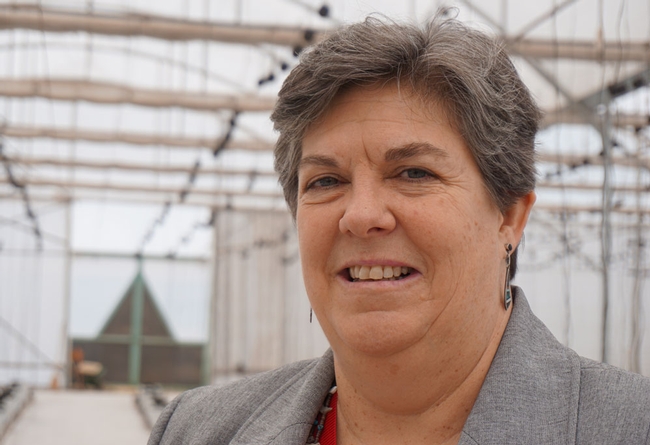
Humiston is one of six higher education witnesses who will speak at the hearing, which is being held as Congress considers provisions of the 2018 Farm Bill.
The hearing takes place at the Longworth House office Building in Washington, D.C., and will be streamed live and recorded on YouTube.
In announcing the hearing, the chair of the House Committee on Agriculture, Michael Conaway of Texas, said ag research has been essential to U.S. gains in productivity over the past century.
"With the global population expected to reach 9.7 billion by 2050, U.S. production agriculture will continue to be asked to produce more with fewer resources and the best way to do that will be through strategic investments in agricultural research," Conaway said. "I look forward to hearing from university leaders about the opportunities and challenges they face in ensuring American agriculture remains a world leader in cutting-edge technology and research.”
Following are highlights from Humiston's prepared remarks:
- A recent study found the return on investment for federal funding of the public land-grant system averages 21:1, corresponding to annual rates of return between 9 percent and 10 percent.
- With the University of California (UC) Agriculture and Natural Resources (ANR) serving as a vital partner, California's $47 billion agricultural sector continues to make California the nation's top agricultural state.
- In the past fiscal year, UC ANR has served more than 1.4 million adults and youth directly, published about 1,800 peer-reviewed journal articles and filed more than 20 patents.
- Federal and state funds are leveraged to secure federal competitive grants, grants from private industry, and other gifts and awards for research at the nation's land-grant universities.
- Although progress is being made to incrementally increase appropriations to the USDA Agriculture and Food Research Initiative, it remains funded at considerably less than the $700 million authorized in the previous two Farm Bills.
Humiston will explain that universities are uniquely set up to allow collaboration among experts in different subjects to solve complex problems and she will give a few examples of multidisciplinary projects, including development of a product to improve the shelf-life of fresh produce and reduce food waste:
“James Rogers studied flexible solar cells at UC Santa Barbara and Lawrence Berkeley National Laboratory. A radio program on world hunger gave the materials scientist his “aha!” moment in 2012. His work on thin-film polymers from solar cells, coupled with information from UC Cooperative Extension, led to an invisible, edible and tasteless barrier that can protect food crops and dramatically improve longevity of produce freshness – using waste plant parts often left on the farm. Apeel Sciences now supports 71 employees and hits shelves this summer, when some of the world's largest avocado producers start using it.”
For a transcript of Humiston's full prepared remarks, see http://ucanr.edu/files/264186.pdf.
UC Agriculture and Natural Resources researchers and educators draw on local expertise to conduct agricultural, environmental, economic, youth development and nutrition research that helps California thrive. Learn more at ucanr.edu.
Workshops aim to boost local and regional food businesses with federal grants

The workshops are designed to help potential applicants understand, develop and submit federal grant applications for the Farmers Market and Local Food Promotion programs. The 2014 Farm Bill reauthorized this program, which will provide $30 million in grants each year through 2018. The funds will be divided between the Farmers Market Promotion Program and the Local Food Promotion Program.
The workshop instructor is Jennifer Sowerwine, a UC ANR specialist based at UC Berkeley whose research and extension is focused on development of equitable, economically viable and culturally relevant food systems in metropolitan areas.
“The workshop is open to anyone interested in connecting agricultural producers and consumers through local food systems,” Sowerwine said. “This is a great opportunity to strengthen the local economy, support small-scale farmers, and make fresh, healthy food more accessible to the community.”
The workshops are a collaborative effort involving UC ANR, USDA and Regional Rural Development Centers. They will run from 9 a.m. to 2 p.m. as follows:
April 8 - Berkeley. 155 Kroeber Hall at UC Berkeley
April 10 - Modesto. Stanislaus County Ag Center, 3800 Cornucopia Way, Modesto
April 15 - Davis. UC ANR Building, 2801 Second St., Davis
April 22 - Redding. North Valley Catholic Social Services, 2400 Washington Ave., Redding
Each of the workshops will provide an overview of the grant programs and help in developing project ideas, preparing the proposal and completing the application. All applications much be submitted by 11:59 p.m. Eastern May 14. Sowerwine suggests applicants start the application process as soon as possible to ensure they meet the deadline. To apply, go to http://www.grants.gov. Questions about the process will be addressed at the workshop.
Registration is $10 and includes lunch, training materials and resources. The agenda, details and online registration are on the web at http://ucanr.edu/sites/localfoodpromo. For more information about the program, contact Jennifer Sowerwine at (510) 664-7043, jsowerwi@berkeley.edu. For information about workshop logistics, contact Alex Zabelin, (530) 750-1259, or Saundra Wais, (530) 750-1260, or email anrprogramsupport@ucanr.edu.
The University of California Global Food Initiative aims to put the world on a path to sustainably and nutritiously feed itself. By building on existing efforts and creating new collaborations among UC's 10 campuses, affiliated national laboratories and the Division of Agriculture and Natural Resources, the initiative will develop and export solutions for food security, health and sustainability throughout California, the United States and the world.
